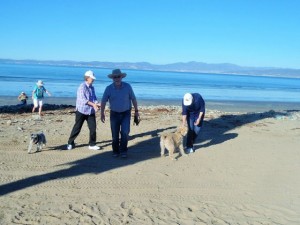
January 7, 2015 – When we arrived in Potrero most of our group had already arrived, as had the warmer weather, always a good sign. We headed off to the border the next day at 10:00 am as we were not using pre-paid tourist visas and were not certain hw much time this would take. Happy to report this process only took us an additional 30 t0 40 minutes. Interesting enough the price has increased to 332 pesos or $29 USD, when you do the math you see that paying in US funds definately cost more, at 14 pesos per 1 USD (now 14.64) the fee should be under $24 USD, not $29 USD. Wisely we paid in pesos. After a quick stop at the Potrero General Store for ice we were back at the campground, before 11:30 am. We hosted the orientation and rendezvous receception at 2:30 pm, the wind seemed to have faded as we reached a high of 25C, very nice indeed. As always Lisa provided a great spread, the beer & wine flowed and the ganf got to know each other a little better and the Baja adventure before them.

8:30 am came quickly the next day and after our pre-trip daily meeting we were on our way. At the Mexican border the were keen to know if we had beer, wine or if we were importing new items, this was all about collecting taxes. They are rebuilding a number of roads in Tecate so we had to take a couple of different turns than usual but no one got lost and we were out of town in about 40 minutes. Off we headed thru the Valley of Guadalupe and Ensenada which always includes a stop at COSTCO. Much to our surprise we ran into Chris & Wayne Kirby, folks that we have not seen for many years from Newton now living in Vancouver and Ensenada. Back in the day we worked a lot together on many local Surrey political campaigns, nowadays Mexico is a much bigger part of our lives.

Following the shopping, lunch and ATM stop we headed off to our destination in Punta Banda, Villarino’s Campground & RV Park. After setup we were off to La Bufadora. There was no cruise ship in and the ocean was quite calm so I did not expect big crowds or thunderous water gushes at the blowhole. What did suprise me was all the parked cars and closed shops. Speaking with a couple of vendors I learned the Federales had been there to enforce an eviction order after a court loss regarding a land dispute with a local Ejido. We did see some shops setting up shop and returning goods to their stores. We will see what happens with this dispute. This morning we are off to see Fidel and some serious beach time.

Did you know?
If you fish below the border, tuna pens are not an unfamiliar term. You can find them in the lee of south island as well as at Puerto Escondido Bay sheltered to the north by Punta Banda and farther down the Baja Coast at Magdalena Bay. These huge circular pens, roughly 150-feet wide and 50 feet deep, are the temporary homes to Bluefin tuna that are fattened up before being sent to the Japanese fish market – sometimes while still in the nets while being towed at an agonizingly slow two knots across the Pacific.
There have been several stories of sportfishers who have collided with the pens under tow.

On July 26, 2008, Wayde Nichols and his friends aboard his 48-foot Señor Jefe made the news when they managed to steer their boat into the middle of a floating tuna pen nearly half the size of a football field. The incident occurred in international waters about 30 miles southwest of Ensenada and is one of several involving the increasing number of pens off Baja California. During their 12-hour ordeal in the tuna pen, the Señor Jefe crew members alternated between fright and excitement. During the period of intense negotiations to free their boat, they experienced the adrenaline rush of a wide-open tuna bite inside the pen which was recounted in WON by Nichols and crew member, Anthony Saputo. See:
http://www.wonews.com/t-FeatureArticle-AccidentlandsSenorHefeintunaheaven-073108.aspx
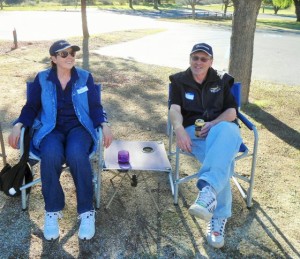
Several years later, on Sept. 8, 2011, a sport boat and a couple of other smaller boats were seen trolling in the wake of a floating tuna pen being towed west at two knots. One of the captains who were present at the time commented that tuna around the net was a new twist. “I’ve fished for tuna beneath kelp paddies, whales, in pods of dolphin and porpoise – but never tuna pens.” Another new twist was when reports surfaced last month of tuna pens being towed south around Baja’s tip. On Jan. 6, a local boat spotted a very slow-moving large vessel about 25 miles to the northwest of the Cabo Falso Lighthouse. One local yacht reported it was a converted shrimp boat towing a tuna pen very slowly toward the southwest. The captain commented that the fish were so thick near the pen that his lures were getting hit before he could get them out. Plenty of tuna, dorado and wahoo, as well as striped marlin, were spotted as the boat and net continued past the tip and up into the Sea of Cortez. Needless to say, the news spread and a small armada of Cabo boats returned the next day and enjoyed similar results.

Over the week, several more nets were seen being tugged north past the tip farther offshore out of range of the Cabo fleet past Los Frailes followed by fish congregating around the pens. They were discovered by the East Cape fleet that raced to greet these slow moving FADS (fish aggregating devices) making their way up the Sea of Cortez to undisclosed locations near La Paz. While it is still an oddity to see these huge pens filled with tuna moving at a snail’s pace offshore anywhere, what seemed highly unusual this time, was that the pens were headed in the wrong direction. In the past, they had been basically either heading northward up Baja’s west coast or westerly toward Japan.

After doing some research, Ted Dunn, Partner/Project Manager of Maricultura Del Norte, whose resume states: In 1996, he joined partnership with Phillipe Charat to form Ocean Farmers and Maricultura Del Norte to pioneer and create the first Tuna Farms in the Americas based in Ensenada Baja, CA. Ted manages all capturing and holding for Maricultura Del Norte. Dunn volunteered to shed some light on the mystery of pens moving in an unusual direction. It seems that the aquaculture research scientist concluded that the tuna would grow more quickly in the warmer water in the Sea of Cortez.
Tales of big fish being towed thousands of miles in huge nets, if told to the captains of the San Diego’s tuna seiner fleet of years past, would have earned looks of disbelief followed by laughter. Today, it’s just another high-seas hazard that might give you grief or provide you with some of the best catches of the day.
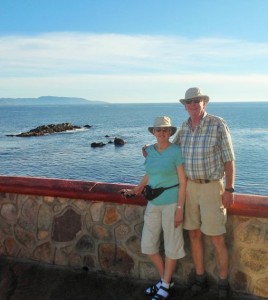
Tuna are predator fish that can reach speeds of 80 km/hr. Because bluefin tuna (bluefin) have a slightly higher core body temperature, they can survive in and adapt to cooler waters than other fish species. As a predator Tuna feed on mackerel, squid, herring and jellyfish. They can be found throughout the Atlantic Ocean, the Mediterranean Sea, and the Pacific Ocean and sometimes even in the North Sea. There are many different species of tuna, all of which are threatened by overfishing.
Around 1940, the global tuna catch was 300,000 tons, most of it fished by hook and line. In 2010, 4,000,000 tons of tuna were caught, primarily with purse-seine nets. 68% are caught in the Pacific Ocean (South Pacific Ocean), 22% in the Indian Ocean and 10% in the Atlantic Ocean and Mediterranean Sea. Catches of skipjack represent approximately 60% of global commercial tuna, followed by yellow fin tuna (24%), Big-eye tuna (10%), Albacore (5%) and Bluefin tuna (only 1 to 2%). The southern Bluefin tuna and the northern Bluefin tuna are threatened with extinction. The Big-eye tuna and yellow fin tuna are heavily overfished. The long-tail tuna, the black fin tuna and the white tuna or albacore are overfished. In the months of May, June and July, the Atlantic Bluefin tuna migrate in large numbers from the Atlantic Ocean to the warmer Mediterranean Sea to spawn. Tuna-fishing has been practiced in the Mediterranean for at least 2,000 years. However, large-scale industrial fisheries have caused the demise of large tuna.
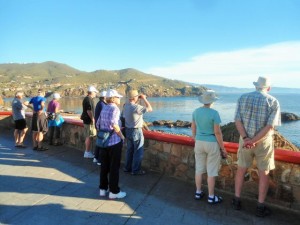
In the next 20 years, the kind of fishing that humans have practiced for thousands of years will be confined to the dustbin of history. Stocks of Bluefin tuna are at an all-time low, a mere 10% of its population size 50 years ago. Top specimens of 900kg have disappeared altogether; the largest tuna now weigh in at only 300 kg. In 2010, the average recorded weight was between 40 and 80 kg. The tuna fleet has an over-capacity of 400%. That means that industrial fisheries are exceeding the sustainable limit by more than four-fold. High-tech boats equipped with the latest detection equipment and ever-increasing catch capacity are racing to capture a handful of fish in the last-remaining spawning areas of the Mediterranean Sea. Despite an international ban, small planes are employed to detect the tuna quickly and efficiently. Not a single fish slips under the radar. Furthermore, tuna catch from illegal, unreported fishing is another major cause for concern.

Bluefin tuna, otherwise known as giant tuna, are mainly eaten as sushi and sashimi. The consumption of sushi and sashimi in particular has driven the Bluefin tuna to the edge of extinction. Bluefin tuna is now classified as ‘critically endangered’. Humanity’s insatiable demand for tuna continues to rise. The viswijzer * is a ‘good fish guide’ to sustainably caught and ethically sourced fish that are not endangered. Bluefin tuna is on the Red list. No tuna species are left on the Green list. At least 85 percent of tuna caught in Europe is exported to Japan. Tuna connoisseurs turn their noses up at pen-reared tuna. A low-quality, low-cost product. Farmed tuna is used in the mass production of sushi and sashimi in cheaper sushi restaurants and supermarkets. According to scientists, conservationists and environmental organizations, market traders and fish specialists, the mass export of tuna for the Japanese market is largely to blame for sounding the death knell for the bluefin tuna. Reports emanating from the big Tsukiji fish market and all other fish auction in Japan confirm the sense of impending doom. The sight of fresh bluefin tuna being pen-reared in the Mediterranean Sea is what Spanish tuna expert Roberto Mielgo calls ‘bloodcurdling’.
